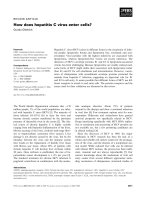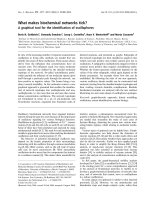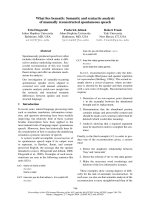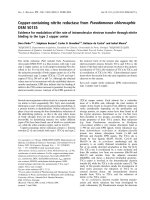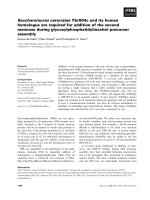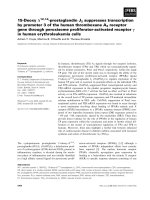Báo cáo khoa học: "What does high NT-proBNP mean in septic shock patients? A part of the puzzle" pdf
Bạn đang xem bản rút gọn của tài liệu. Xem và tải ngay bản đầy đủ của tài liệu tại đây (31.86 KB, 2 trang )
Page 1 of 2
(page number not for citation purposes)
Available online />Abstract
B-type natriuretic peptide (BNP) and amino-terminal pro-BNP (NT-
proBNP) plasma levels are commonly high at the early phase of
septic shock and have been suggested to be prognostic markers
for this condition. It is uncertain, however, whether this increase
reflects sepsis related cardiac dysfunction. In a recent issue of
Critical Care, Mokart and coworkers showed the accuracy of NT-
proBNP in predicting intensive care unit mortality in cancer
patients with septic shock, which could help in identifying high risk
cancer patients. Results from repeated transthoracic
echocardiographs show that NT-proBNP on day 2 after admission
was higher in patients presenting with cardiac dysfunction,
whereas NT-proBNP on day 1 did not predict cardiac dysfunction.
These data suggest that after an initial overexpression of NT-
proBNP in all septic patients, patients with cardiac dysfunction will
present persistent high levels of NT-proBNP.
In this issue of Critical Care, Mokart and coworkers [1] report
the results of a prospective cohort study evaluating plasma
amino-terminal pro-B-type natriuretic peptide (NT-proBNP) as
a marker of prognosis and cardiac dysfunction in cancer
patients with septic shock. They included 51 patients, mainly
with hematological malignancies. By univariate analysis,
Logistic Organ Dysfunction score, early NT-proBNP level and
recent hematopoietic stem-cell transplantation were
associated with intensive care unit (ICU) mortality. In a
multivariate analysis, NT-proBNP level on day 2 was the
unique parameter associated with mortality. The area under
the curve was 0.87. Transthoracic echocardiography was
repeated in 45 patients. NT-proBNP level on day 2 but not on
day 1 was significantly higher in patients presenting a left or
right cardiac dysfunction during the course of the septic shock.
BNP and its amino-terminal fragment, NT-proBNP, are mainly
produced by myocytes in response to a ventricular volume
expansion or pressure overload. Their levels in blood are,
therefore, accurate markers of ventricular dysfunction and
have been shown to be associated with mortality in various
cardiac diseases. In ICU patients, although BNP and
NT-proBNP are not correlated with filling pressures [2,3], low
levels of BNP have been shown to have a high negative
predictive value for the presence of cardiogenic shock [2]. In
septic shock patients, several studies have reported very high
levels of BNP and NT-proBNP [4-7] and have suggested that
NT-proBNP is an independent marker of prognosis in this
population [6,7]. It remains unclear, however, whether
NT-proBNP is high in these patients because they all present
with a certain degree of cardiac dysfunction and whether the
NT-proBNP level is associated with mortality by reflecting the
intensity of this dysfunction. Firstly, experimental studies have
shown that endotoxin and some cytokines are able to
upregulate the transcription of the gene encoding BNP [8,9];
therefore, the extent of the inflammatory response could
account, at least in part, for the dramatically high levels of
NT-proBNP reported during septic shock. Secondly, cardiac
dysfunction during sepsis is complex and can be associated
with left and right as well as systolic and diastolic
dysfunctions [10,11]; therefore, the respective contribution of
these dysfunctions to an increase in NT-proBNP is difficult to
determine. However, knowledge of the determinants of the
secretion of natriuretic peptides during septic shock is
necessary prior to considering NT-proBNP as a potential tool
to guide therapy of these patients.
Like previous reports, Mokart and coworkers show that all
patients at the early phase of septic shock exhibit high levels
of NT-proBNP. They also confirm the prognostic value of
early NT-proBNP measurement and show that this also
applies to cancer patients. As for other reports, it is
noteworthy that the samples of patients are small and that the
odds ratios for the effect of NT-proBNP on mortality are large.
Commentary
What does high NT-proBNP mean in septic shock patients?
A part of the puzzle
Antoine Roch
Service de Réanimation Médicale, Hôpitaux Sud, boulevard Sainte Marguerite, 13274, Marseille cedex 9, France
Corresponding author: Antoine Roch,
Published: 13 April 2007 Critical Care 2007, 11:122 (doi:10.1186/cc5728)
This article is online at />© 2007 BioMed Central Ltd
See related research by Mokart et al., />BNP = B-type natriuretic peptide; ICU = intensive care unit; NT-proBNP = amino-terminal pro-BNP.
Page 2 of 2
(page number not for citation purposes)
Critical Care Vol 11 No 2 Roch
Moreover, the role of anthracyclin treatment in the myocardial
dysfunction deserves further investigation. Mokart and
coworkers also confirm the association of NT-proBNP level
with cardiac dysfunction. In a seminal paper, Charpentier and
coworkers [5] reported higher BNP levels in septic patients
with altered left ejection fraction. In the study by Mokart and
coworkers, NT-proBNP on day 1 did not predict cardiac
dysfunction; however, a key result from this study is that NT-
proBNP continued to rise on day 2 in patients developing
cardiac dysfunction whereas it quickly decreased in the
others. This result suggests that mechanisms other than
cardiac wall stress (such as inflammatory mediators or
neurohormonal activation) could be involved in the initial
upregulation of BNP and NT-proBNP secretion, whereas
cardiac dysfunction could contribute to persistent high NT-
proBNP levels.
A limitation of the study by Mokart and coworkers is the lack
of serial measurements of NT-proBNP over several days,
which could help to confirm this tendency. To date, the
relationship observed between BNP or NT-proBNP and
sepsis related myocardial dysfunction remains insufficiently
described to propose them as markers of cardiac failure
during septic shock. Left dysfunction could be predominant in
some patients whereas right dysfunction could complicate
respiratory failure in others. Mokart and coworkers show that
NT-proBNP could not discriminate these patients.
Future studies will have to precisely identify the determinants
of the secretion of natriuretic peptides during human sepsis
as well as the confounding factors affecting their levels in ICU
patients. The great sensitivity of NT-proBNP in predicting
prognosis could be largely counterbalanced by a lack of
specificity for cardiac depression. Studies with larger
samples of patients should also determine whether
NT-proBNP or BNP measurement can contribute to risk
stratification of septic shock patients.
Competing interests
The author declares that they have no competing interests.
References
1. Mokart D, Sannini A, Brun JP, Faucher M, Blache JL, Blaise D,
Faucher C: NT-proBNP as an early prognostic factor in cancer
patients developing septic shock. Crit Care 2007, 11:R37.
2. Tung RH, Garcia C, Morss AM, Pino RM, Fifer MA, Thompson BT,
Lewandrowski K, Lee-Lewandrowski E, Januzzi JL: Utility of B-
type natriuretic peptide for the evaluation of intensive care
unit shock. Crit Care Med 2004, 32:1643-1647.
3. Januzzi JL, Morss A, Tung R, Pino R, Fifer MA, Thompson BT, Lee-
Lewandrowski E: Natriuretic peptide testing for the evaluation
of critically ill patients with shock in the intensive care unit: a
prospective cohort study. Crit Care 2006, 10:R37.
4. Chua G, Kang-Hoe L: Marked elevations in N-terminal brain
natriuretic peptide levels in septic shock. Crit Care 2004, 8:
R248-250.
5. Charpentier J, Luyt CE, Fulla Y, Vinsonneau C, Cariou A, Grabar
S, Dhainaut JF, Mira JP, Chiche JD: Brain natriuretic peptide: A
marker of myocardial dysfunction and prognosis during
severe sepsis. Crit Care Med 2004, 32:660-665.
6. Brueckmann M, Huhle G, Lang S, Haase KK, Bertsch T, Weiss C,
Kaden JJ, Putensen C, Borggrefe M, Hoffmann U: Prognostic
value of plasma N-terminal pro-brain natriuretic peptide in
patients with severe sepsis. Circulation 2005, 112:527-534.
7. Roch A, Allardet-Servent J, Michelet P, Oddoze C, Forel JM,
Barrau K, Loundou A, Perrin G, Auffray JP, Portugal H, Papazian
L: NH2 terminal pro-brain natriuretic peptide plasma level as
an early marker of prognosis and cardiac dysfunction in
septic shock patients. Crit Care Med 2005, 33:1001-1007.
8. Tomaru Ki K, Arai M, Yokoyama T, Aihara Y, Sekiguchi Ki K,
Tanaka T, Nagai R, Kurabayashi M: Transcriptional activation of
the BNP gene by lipopolysaccharide is mediated through
GATA elements in neonatal rat cardiac myocytes. J Mol Cell
Cardiol 2002, 34:649-659.
9. Ma KK, Ogawa T, de Bold AJ: Selective upregulation of cardiac
brain natriuretic peptide at the transcriptional and transla-
tional levels by pro-inflammatory cytokines and by condi-
tioned medium derived from mixed lymphocyte reactions via
p38 MAP kinase. J Mol Cell Cardiol 2004, 36:505-513.
10. Jardin F, Brun-Ney D, Auvert B, Beauchet A, Bourdarias JP:
Sepsis-related cardiogenic shock. Crit Care Med 1990, 18:
1055-1060.
11. Poelaert J, Declerck C, Vogelaers D, Colardyn F, Visser CA: Left
ventricular systolic and diastolic function in septic shock.
Intensive Care Med 1997 23:553-560.

